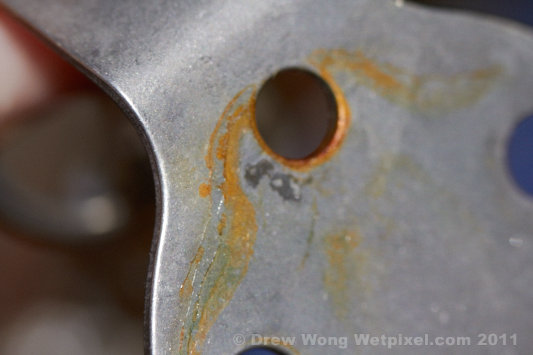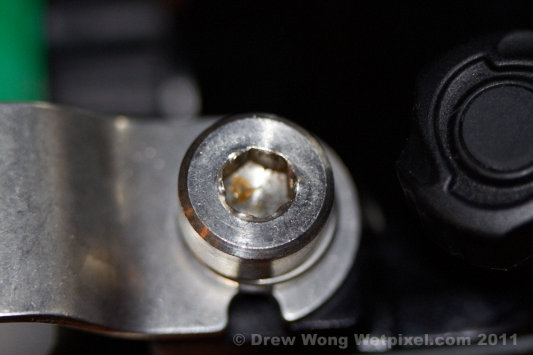Nauticam NA-60D field test
Macro:
*Much of the macro AF and metering modes have been discussed in the Seacam Prelude 60D Review*
The first thing I want to say about the Nauticam macro port is echo what Alex Mustard said in his review: “The neoprene cover is horrible!” There’s no tension due to the shape of the port so it slips off faster than it can be put on. It’s so bad there are home-made remedies by Wetpixel members.
Otherwise, the housing works well with macro as well, especially with the TTL capability in the optical ports. The focus light mount is on the port and needs a shoe adapter to work. I didn’t have this adapter and hence I used the lights from the Inons to help focus, which was adequate
![]()
Saron Shrimp. 1/160 f13 ISO100 ETTL Evaluative FEC -2/3. Canon 100mm f2.8L with 25mm extension tube
The NA-60D performed well with the 100mm macro lens + 25mm extension tube. I used the 30mm extension ring with the macro port. When I needed to change things like AF points, the ability to have one button press was very nice. Ergonomically the ISO lever was very convenient. The AF-ON lever took some getting used as I was accustomed to just bending my thumb. However, these are the things that one adapts to as an owner.
![]()
Blenny in algae. 1/125 f14 ISO200 ETTL Evaluative FEC -2/3. Canon 100mm f2.8L with 25mm extension tube
Most of the shots I took were with ETTL from the camera in Evaluative mode. I did experiment with STTL on the Inon Z240 a few times, just to see the difference in metering. STTL works best if the strobe is pointed directly at the subject for metering. Otherwise, the NA-60D is a very nice macro rig.
![]()
Juvenile Banggai Cardinalfish. The 60D’s AF did well with moving little fish. 1/125 f10 ISO100 ETTL Evaluative FEC 0. Canon 100mm f2.8 extension tube 25mm
This section does seem anemic but it’s because the NA-60D just worked and so did the camera. Hard to come up with things to say when things go well. My description of how the 60D works in macro can be found here. Now onto video…
Video:
*The video modes have been reviewed thoroughly in the Seacam Prelude 60D review*
The 10-17 behind the minidome. Quality isn’t affected by the small diameter dome (at least on a 27” screen.
With the Liberty wreck as the testing ground, I was particularly interested to test the mini-dome for video, especially for handling issues. I’d not seen too many samples of video using mini-domes.
Switching to video, the NA-60D control for REC surprised me. The lever pressed down and I assumed it would rebound back out. The lever stayed down and kept the Liveview/REC button down, which isn’t a problem except I pressed to stop recording and not getting any feed back, I assumed it stopped but recording kept going on.
Other than that very minor issue, the video from the mini-dome was nice with the Tokina 10-17. The resolution was good and the corners were even. There weren’t bad reflections either. Balancing the housing was difficult due to the small dome footprint. The buoyant characteristic of the port still made the housing go nose up. I used a garden hose velcro strap to hold a 300g weight. This was also the emergency ballast I normally have on my own housings. It’d keep the housing negative but if I had to let go of the housing for any reason, the rig would float back up to the surface.
At the end of the video, the rubber ring falls out. If you are not using internal flash, take it off.
Conclusion
When I finished my last dive of the test, I thought overall, the NA-60D was an excellent housing. The AF-ON lever is a bit counter intuitive for me, but with access to all controls, excellent port lock system and design with the shooter in mind, I can’t say that’s an issue at all. Furthermore Nauticam has a good range of accessories. I could see why the brand is so popular. I was duly impressed.
While I was packing up and disassembling the rig when I found that one of the hex screws on the housing had seized stiff. I thought it was just grit so I put a little muscle on it and rounded the screw. When I removed the ball joints separately, I found rust on the metal plates and screws. They looked like they were made of different metals so some sort cathode/anode reaction came about in the 3 weeks I tested the housing. I’d only disassembled it once for transport into Indonesia and I put lube on each screw tread as a precaution. I also soak my housings for 20 minutes at the end of each day in fresh water. Did I mess up somewhere?

The rusting metal ring This happened after 2 weeks of diving where the housing was soaked/rinsed daily
It was then I remembered that Nauticam had a few issues with rust around the viewfinder rings, which a Nauticam dealer, Alex Tattersall, claimed to be an substandard materials issue with one of their suppliers and was dealt with. However, I’d never seen any report of screwed and plates having rust issues, and this was a brand new housing made in August 2011.

The rounded bolt for the housing mount.
I will say that I know many owners of Nauticam products who love their housings and have had no issues that they know of. Adam Hanlon and Alex Mustard are very happy with their Nauticams. Corrosion issues have hit other manufacturers so it’s not unique to Nauticam. That said, the fact is that these things happened during the review time. It is difficult to give an excellent score to and/or recommend a product with such quality control issues.
Overall, the functionality of the NA-60D and accessories were excellent and the design ingenuity was very good. It’s the quality control of Nauticam products I’m forced to question. Nauticam has admitted the issues with quality control of the steel used and redesigned the dome port after acknowledging the problem. So they are working on the problems. However, the quality issue doesn’t seem to be a one off or a bad batch problem since it’s continued from the 550D to the 60D now. Are the issues a red herring to an otherwise good manufacturer? I can’t say and only the potential buyer can decide whether this issue will hamper their decision.
MSRP of equipent tested (Provided by Sanah of Scubacam Singapore):
NAUTiCAM 60D Housing US$3,000.00
9” Optical Glass DP US$1,900.00
Macro Port 87 US$400.00
4.33” Acrylic DP for T10-17 US$620.00
Subjective Ratings:
Pros:
- Complete control over camera functions.
- Great design with shooter in mind (ISO lever in the hot zone etc)
- Dual strobe connection type with S6/N5 option.
- Good range of ports and accessories
Neutral:
- No hole for accessory mounting on the top of the housing.
- Rubber ring to keep light leak (should be more secure)
Cons:
- Recurring quality control issues over different housings for different cameras.